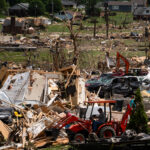Damage estimates from Sunday’s 7.2 magnitude earthquake in Mexico, just south of California, are not expected to exceed $1 billion, and insured losses should not exceed $300 million, according to risk modeling firm EQECAT.
Sunday’s quake struck about 19 miles southeast of Mexicali, about 16 miles from Baja, Calif., according to U.S. Geological Survey reports. This earthquake ruptured on the Laguna Salada fault, whose last major earthquake occurred in 1892, to the northwest of the recent rupture. Although the earthquake was felt throughout a vast area of Mexico and throughout Southern California, and as far as Las Vegas, damage and loss are expected to be focused in the epicentral region, Oakland, Calif.-based Eqecat said.
“While it is inevitable that comparisons will be drawn, the Baja earthquake was not related to the M 8.8 earthquake in Chile on February 27,” said Dr. Mehrdad Mahdyiar, director of earthquake hazard at AIR Worldwide. The Chile earthquake occurred on a different plate boundary — between the Nazca and South American plates — and generated some 250 times more energy, he said.
Damage is expected to be widespread in the community of Mexicali, the largest urban area affected by Sunday’s event. The ground shaking experienced in Mexicali was of an intensity typically associated with moderate-to-heavy damage in vulnerable structures such as unreinforced masonry, Eqecat said.
“Insured residential properties in Mexico are dominated by confined masonry construction, which is unreinforced masonry surrounded by a thin reinforced concrete shell. Commercial properties tend to be constructed of confined masonry or reinforced concrete,” Mehrdad said. “Depending on the level of earthquake resistant design implemented and the age of the buildings, some damage to beam-column connections, walls, and to other structural elements can be expected in areas close to the epicenter.”
Currently, a single national building code for structural design does not exist in Mexico. The enactment and adoption of building codes are subjected to the government department in each of the more than 2,400 municipalities. Some regions of the country with large population concentrations, such as Mexico City, have developed their own seismic provisions, widely known as the Mexico City Building Code (MCBC). Consequently, many local building code authorities generally base their codes on the MCBC.
Thus far, damage reports have been limited in geographic scope and heaviest in the border towns of Mexicali and Calexico on the U.S. side. Local officials have declared a state of emergency in Mexicali, a major metropolitan area with a population of more than 650,000 and the capital of Mexico’s Baja California state. More than a dozen fires broke out in the Mexicali area, likely as a result of ruptured gas tanks and lines, Mehrdad added.
The town’s older unreinforced masonry buildings, many built in the 1930s and 1940s, have not been retrofitted for ground shaking. Large cracks are apparent in some walls, making the possibility of collapse from aftershocks a concern.
The largest U.S. city affected by the earthquake is El Centro, Calif., although significantly less damage is expected there than in Mexicali, due both to lower-intensity ground shaking and less-vulnerable structures. There, the damage seems to have been restricted to shattered shop-front windows and some collapsed ceilings.
Structures with greater earthquake resistance may have experienced slight to moderate damage. The intensity of shaking that occurred in El Centro and other U.S. locations is below the threshold typically associated with structural damage, EQECAT said.
The risk modeling firms said they will continue to monitor the damage.
Meanwhile, California is using the quake as a reminder that its residents should consider purchasing earthquake insurance, to ensure they are adequately covered should an event of similar magnitude affect the Golden State.
Insurance Commissioner Steve Poizner urged all consumers to equip themselves and their homes for earthquakes and to evaluate their individual needs for earthquake insurance.
“Sunday’s earthquake reminded millions of Californians that our state is home to many devastating natural disasters,” Poizner said. “Because earthquakes can strike at any time without warning, it is vital for homeowners to prepare now for the possibility of a catastrophic loss. I urge every consumer to evaluate their individual need for earthquake insurance, and to regularly inventory their belongings to make sure their existing homeowners coverage is adequate.”
A 2008 National Association of Insurance Commissioners survey revealed that the majority of American consumers do not have the coverage necessary to protect themselves from specific types of losses that are not reimbursed under standard policies. Based on a data call by the Department of Insurance, almost 90 percent of homeowners and renters do not have earthquake insurance.
Sources: AIR, EQECAT, DOI
Was this article valuable?
Here are more articles you may enjoy.

 UBS Client Can’t Sue Bank Over Broker’s Alleged Affair With Wife
UBS Client Can’t Sue Bank Over Broker’s Alleged Affair With Wife  Two Chevron Workers Die of Injuries From Angola Platform Fire
Two Chevron Workers Die of Injuries From Angola Platform Fire  Fixing the Claims Experience Where It Matters Most: In the Mess
Fixing the Claims Experience Where It Matters Most: In the Mess  Trump Administration Targets Resiliency Funds to Shrink FEMA’s Role
Trump Administration Targets Resiliency Funds to Shrink FEMA’s Role 